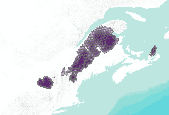|
|

This dataset depicts Lynx (Lynx canadensis) habitat in the Northern Appalachians predicted using the spatially explicit population model PATCH under the population cycling only in Gaspe (core area) plus trapping scenario (B2; Carroll 2007). This dataset represents one of several scenarios testing the interacting effects of population cycling, trapping, territory size, and climate change on lynx populations. Static habitat suitability models for lynx were fed through PATCH to predict source and sink habitat areas across the landscape. The static models for lynx were created based on a logistic regression model of reported lynx locations against the proportion of the landscape in deciduous forest cover and annual...

This dataset depicts Lynx (Lynx canadensis) habitat in the Northern Appalachians predicted using the spatially explicit population model PATCH under the population cycling only in Gaspe (core area) plus 36 square kilometer territory size (compared to 90 square kilometer territory) scenario (B136; Carroll 2007). This dataset represents one of several scenarios testing the interacting effects of population cycling, trapping, territory size, and climate change on lynx populations. Static habitat suitability models for lynx were fed through PATCH to predict source and sink habitat areas across the landscape. The static models for lynx were created based on a logistic regression model of reported lynx locations against...

This dataset depicts Lynx (Lynx canadensis) habitat in the Northern Appalachians predicted using the spatially explicit population model PATCH under the no population cycling plus trapping plus 36 square kilometer territory size (compared to 90 square kilometer territory) scenario (A236; Carroll 2007). This dataset represents one of several scenarios testing the interacting effects of population cycling, trapping, territory size, and climate change on lynx populations. Static habitat suitability models for lynx were fed through PATCH to predict source and sink habitat areas across the landscape. The static models for lynx were created based on a logistic regression model of reported lynx locations against the proportion...

This dataset depicts Lynx (Lynx canadensis) habitat in the Northern Appalachians predicted using the spatially explicit population model PATCH under the population cycling only in Gaspe (core area) scenario (B1; Carroll 2007). This dataset represents one of several scenarios testing the interacting effects of population cycling, trapping, territory size, and climate change on lynx populations. Static habitat suitability models for lynx were fed through PATCH to predict source and sink habitat areas across the landscape. The static models for lynx were created based on a logistic regression model of reported lynx locations against the proportion of the landscape in deciduous forest cover and annual snowfall. Demographic...

This dataset shows simulated fisher territory occupancy for a study area the southern Sierra Nevada range from the Extreme Fire Regime plus No Treatment scenario (Scheller and others 2008). Simulations were conducted using the spatially dynamic population model PATCH coupled to the forest succession and disturbance model LANDIS-II. Fisher occupancy is represented as the average number of females per 860 hectare hexagon. Habitat quality was derived from LANDIS-II simulated vegetation dynamics and was used to drive spatially-explicit demographic dynamics in PATCH> The baseline fire regime is derived from the previous 20 years of fire data. The extreme fire regime is a purely hypothetical fire regime intended to produce...

This dataset depicts Lynx (Lynx canadensis) habitat in the Northern Appalachians predicted using the spatially explicit population model PATCH under the population cycling only in Gaspe (core area) plus climate change scenario (FB1; Carroll 2007). This dataset represents one of several scenarios testing the interacting effects of population cycling, trapping, territory size, and climate change on lynx populations. Static habitat suitability models for lynx were fed through PATCH to predict source and sink habitat areas across the landscape. The static models for lynx were created based on a logistic regression model of reported lynx locations against the proportion of the landscape in deciduous forest cover and...

This dataset shows simulated fisher territory occupancy for a study area the southern Sierra Nevada range from the Baseline Fire Regime plus No Treatment scenario (Scheller and others 2008). Simulations were conducted using the spatially dynamic population model PATCH coupled to the forest succession and disturbance model LANDIS-II. Fisher occupancy is represented as the average number of females per 860 hectare hexagon. Habitat quality was derived from LANDIS-II simulated vegetation dynamics and was used to drive spatially-explicit demographic dynamics in PATCH> The baseline fire regime is derived from the previous 20 years of fire data. The extreme fire regime is a purely hypothetical fire regime intended to produce...

This dataset depicts Lynx (Lynx canadensis) habitat in the Northern Appalachians predicted using the spatially explicit population model PATCH under the population cycling plus 36 square kilometer territory size (compared to 90 square kilometer territory) scenario (B1; Carroll 2007). This dataset represents one of several scenarios testing the interacting effects of population cycling, trapping, territory size, and climate change on lynx populations. Static habitat suitability models for lynx were fed through PATCH to predict source and sink habitat areas across the landscape. The static models for lynx were created based on a logistic regression model of reported lynx locations against the proportion of the landscape...

This dataset depicts Lynx (Lynx canadensis) habitat in the Northern Appalachians predicted using the spatially explicit population model PATCH under the population cycling only in Gaspe (core area) plus trapping plus climate change scenario (FB2; Carroll 2007). This dataset represents one of several scenarios testing the interacting effects of population cycling, trapping, territory size, and climate change on lynx populations. Static habitat suitability models for lynx were fed through PATCH to predict source and sink habitat areas across the landscape. The static models for lynx were created based on a logistic regression model of reported lynx locations against the proportion of the landscape in deciduous forest...

This dataset shows simulated fisher territory occupancy for a study area the southern Sierra Nevada range from the Baseline Fire Regime plus Moderate Intensity Treatment over 8% of the treatable area scenario (Scheller and others 2008). Simulations were conducted using the spatially dynamic population model PATCH coupled to the forest succession and disturbance model LANDIS-II. Fisher occupancy is represented as the average number of females per 860 hectare hexagon. Habitat quality was derived from LANDIS-II simulated vegetation dynamics and was used to drive spatially-explicit demographic dynamics in PATCH. The baseline fire regime is derived from the previous 20 years of fire data. The extreme fire regime is a...

This dataset shows simulated fisher territory occupancy for a study area the southern Sierra Nevada range from the Extreme Fire Regime plus Moderate Intensity Treatment over 8% of the treatable area scenario (Scheller and others 2008). Simulations were conducted using the spatially dynamic population model PATCH coupled to the forest succession and disturbance model LANDIS-II. Fisher occupancy is represented as the average number of females per 860 hectare hexagon. Habitat quality was derived from LANDIS-II simulated vegetation dynamics and was used to drive spatially-explicit demographic dynamics in PATCH. The baseline fire regime is derived from the previous 20 years of fire data. The extreme fire regime is a...
|
|